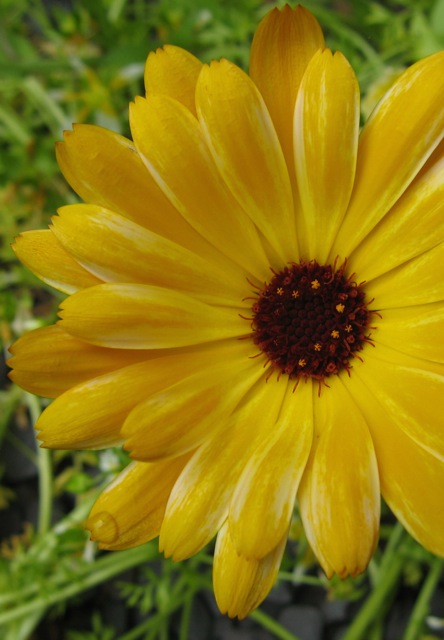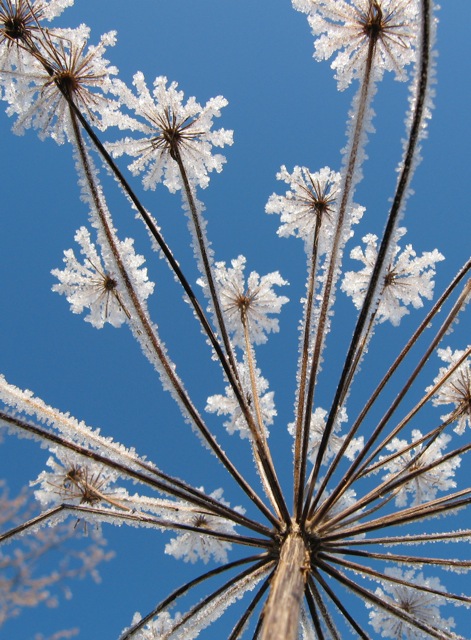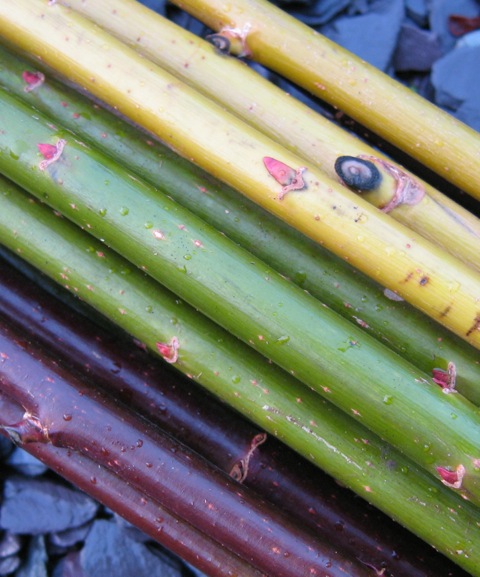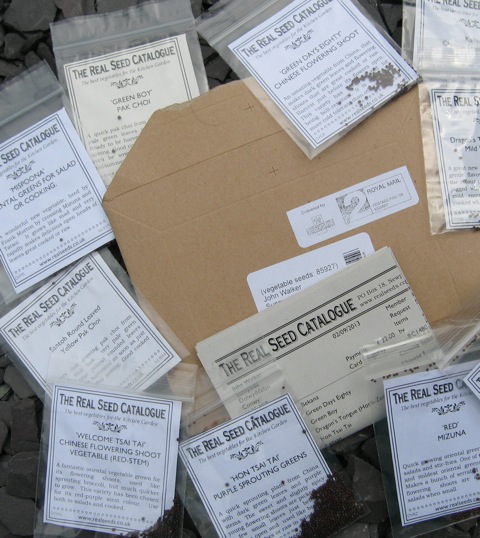I’ll be celebrating 12 gardening days this Christmas, but not all in one go – and not in the usual way.
I’m breaking with seasonal tradition: instead of counting down the 12 days of Christmas, I’m planning to spread a dozen ‘green’ days out across the coming winter months. My 12 days are more to do with reducing, requesting and recommending than with receiving (no partridge for me, although a pear tree is mighty tempting). There’s some seed sharing, reading, weaving, sieving, and some planting, too. I hope they’ll make my gardening efforts (and perhaps yours) a tad more earth-friendly.
My first green day of Christmas involves including a pinch of home-saved pot marigold (calendula) seeds with every card I send. They’ll be from my best single-flowered plants, which are perfect fodder for good bugs of all hues, especially bees and hoverflies, and will be wrapped in a folded square of toilet paper with scant instructions: ‘Sow in spring. Compost the wrapping. Enjoy.’

The prospects for wild solitary bees (and wasps) on my patch will improve on my second day, when I’ll be curtailing that seasonal urge to snip and tidy. Instead, I’ll be leaving dead stems – especially hollow ones – standing, to give garden wildlife somewhere to hole up over winter, and somewhere to nest next spring and summer. You won’t just increase habitat by staying your secateurs; you’ll enjoy a spectacle when encrusting hoar frost arrives.
But those secateurs will be sharp and ready on the third of my green days, when I’ll gather winter stems and evergreens to make decomposable decorations to last from the winter solstice through to the new year. Two years ago I planted a selection of willows, and I’m about to cut my first whippy bunch of bright golden-yellow Salix alba var. vitellina to weave into circles. I’ll use these with holly, ivy and maybe some wild honeysuckle vine. The dry circles can be reused year after year, and when they do disintegrate, they can be shredded and composted, or used as kindling. The pollarded stems will explode with fresh shoots next spring, ready for next winter’s weaving. If there are plenty, I’ll hold back some of the longest, thickest shoots to replant.

Planting will be paramount when my fourth day finds me sniffing around my local garden centre, on the trail of mahonia. These tough evergreens, with their sweet scent and spiky leaves, are autumn and winter manna for bees, hoverflies and other insects foraging for nectar and pollen on mild days. This mish-mash of an autumn has seen some bumblebees out and about well into December (a recent sun-soaked day lifted us to 15°C here in North Wales). I’m on the lookout for Mahonia x media ‘Winter Sun’, which holds its perfumed yellow spikes aloft.
It’s a long shot to expect that my mahonia will be potted in peat-free compost, but my fifth green day will find me visiting local garden centres and nurseries to ask if they will stock a quality peat-free compost (if they don’t already). My must-have mix is SylvaGrow, which bagged a ‘best buy’ in Which? Gardening’s most recent container compost trial (April 2015), and is endorsed by the Royal Horticultural Society. If you can’t persuade your local outlet, SylvaGrow has a useful stockist locator. If you’re a club/society that buys in bulk, they might be able to deliver by the pallet.
That pioneer of peat-free gardening, Geoff Hamilton, will take centre stage on my sixth day, when it’ll be either too wet or too cold to stay outside. Instead, I’ll be re-watching ‘The Geoff Hamilton Collection’ of DVDs, to delight again in how effortlessly and gracefully Geoff conveys the joy of nature-aware organic gardening. The box set contains ‘Cottage Gardens’, ‘Paradise Gardens’ and ‘The Ornamental Kitchen Garden’. Geoff puts most of his modern-day broadcasting counterparts in the shade. The perfect gift, perhaps, for a pesticide-pumping friend.
Delving into a (self-gifted) copy of Cultivating Chaos: How to Enrich Landscapes with Self-Seeding Plants (Timber Press, ISBN: 978-1604696523) will light up my seventh day, no matter how dark it is outdoors. About plants which grow opportunistically, in cracks, crevices and unpredictable places, which need zero coddling and are often hugely beneficial to garden insects and other wildlife, it’s a cracker of an informative, richly illustrated book which already has me fizzing with ideas (for ‘landscapes’ read ‘gardens’).

Louring midwinter will also be ideal for my eighth green day, when I’ll be putting a stop to an unnecessary blizzard of mail order seed, plant and product catalogues. I love thumbing through them, but I don’t need separate catalogues for early, mid and late spring, early summer… and so on. Our finite world doesn’t need endless gobbling of paper, ink, oil (for the plastic wrappers), and energy to print and deliver them. One good tome a year is fine, backed up by an up-to-date website. An ‘I’ll save paper and shop online’ tick box on order forms would be a savvy resource- and money-saving move.
Hot on the heels of averting a catalogue avalanche, my ninth day of going green is when I’ll start scrutinising the ethics of gardening companies. The winners of my gardening pound will be those who are transparent about their ethical and environmental credentials, and who demonstrate that they’re doing their bit to ease the growing burden on the natural world. I want catalogues and websites to explain upfront how ethics and ‘doing the right thing’ are informing and guiding their decisions.
I’ll be able to drop my scrutineer’s hat on my tenth day, when I begin poring over the catalogue from arguably our most ethical and low-impact vegetable seed supplier: The Real Seed Catalogue. Most seeds we buy are produced in far-off lands, under who knows what conditions (for the plants or for the growers). Real Seeds is a small Welsh business which raises all of its own ‘open-pollinated’ seeds, sells them to us, and then positively encourages us to save our own seed from those plants that do best on our plots. Real Seeds doesn’t do F1 hybrids or genetically modified (GM) seeds, and excels at info-packed, recyclable or compostable packaging.

This year delivered some real shockers when it came to mail order packaging. Rock bottom arrived when I ordered a packet each of pea and cosmos seeds. I didn’t expect them to be sent separately, each in a plastic tray (no recycling symbol), inside a plastic-coated cardboard wrapper (which won’t compost), held by a plastic ‘strap’, along with yet another catalogue and a needless rubber band. So, on my eleventh green day, I’ll be looking at who the worst offenders are, and making a note not to buy from them again – unless they can promise me they’ll green up their act by using resources more responsibly, and not add to society’s throwaway mountain. It ain’t what gardening’s all about.
What gardening is all about is being frugal and mindful, knowing nature’s limits, and making something wonderful and enriching from scratch. So my twelfth green day of Christmas will be spent sieving vintage leafmould to a breadcrumb-like consistency, then adding it to worm-worked compost to make a peat-free sowing and potting mix.
Green they’ll be, but 12 days surely won’t be enough…
Text and images © John Walker
Find John on Twitter @earthFgardener


